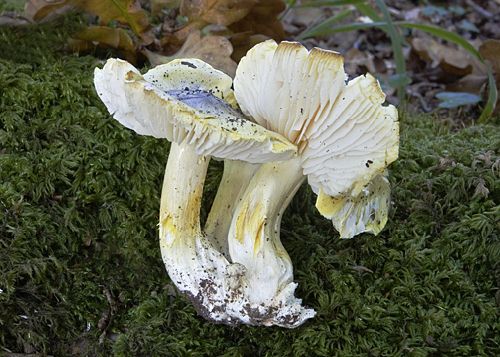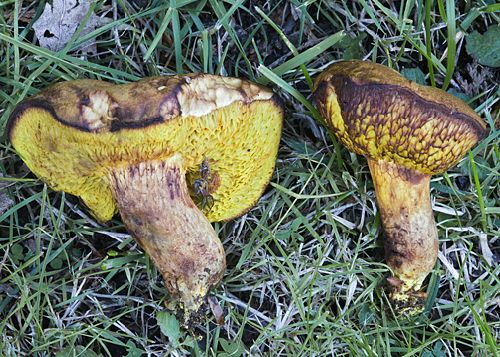Rans Wood and Stubbs Wood
Sat 25 Sep 2010
Field event ID HF1018
OS Grid areas: SU3602 3603
Weather: The day was dry and the sun was out, which slightly suppressed the noticeably chill breeze in the air.
Report: (Mark Jackson) Forayers were out in their droves today as a sizeable gathering mustered in the car park. Once we were organised and Sue had entered all of our names into a laptop, we set off. Thirty seconds into the foray I stumbled across a small troop of Phylloporus rhodoxanthus Syn (pelletieri) a species that is listed as a priority species on the UK Biodiversity Action Plan (UKBAP). Once I had showed Eric he erupted with excitement as he has only seen this species once before and Alan has only seen it a few times before. According to our website there are only two records for this species and neither of these records are in the New Forest. As we were nearing the time and place for lunch, the species list was already quite substantial and Alan was having trouble keeping up with a non-stop trickle of forayers turning up with specimens in hand, Eric once again had too many Russulas to identify at home and Paul was valiantly keeping up with the many photo opportunities. Not far from the lunch spot Alan pointed out specimens of Phellinus robustus occupying one of the six known sites in the forest. We skirted along the edge of the woodland and followed a ride which produced Hydnellum concrescens and later Hydnellum spongiosipes both in the early stages of development. Both these species are vulnerable and are priority species listed on the UKBAP. After lunch the list continued to grow and Alan was forced to leave the ubiquitous Trochila ilicina and Biscogniauxia nummularia off of the list as there was not enough room left on the recording sheets. Species that caught the attention of the eye during the foray were an easily identifiable webcap, Cortinarius purpurascens with its remarkable deep lilac colouring on cutting and the delightfully diminutive Mycena stylobates, the beautifully plum coloured base of Boletus queletii, the golden yellow of Tricholoma sejunctum and the metallic yellow of Hypomyces chrysospermus in its conidial stage. On our way back to the car park we were rewarded with Xerocomus chrysonemus showing its yellow mycelium and the uncommon Lactarius controversus which was found not far from the car park. All in all a very productive day with several vulnerable and uncommon species found.
Species list: Amanita citrina var. alba, Amanita citrina var. citrina, Amanita excelsa var. spissa, Amanita franchetii, Amanita fulva, Amanita muscaria var. muscaria, Amanita pantherina, Amanita phalloides, Amanita porphyria, Amanita rubescens var. rubescens, Amanita vaginata, Annulohypoxylon multiforme, Armillaria mellea, Armillaria ostoyae, Armillaria tabescens, Auricularia auricula-judae, Bjerkandera adusta, Boletus aereus, Boletus badius, Boletus badius, Boletus cisalpinus, Boletus edulis, Boletus luridiformis var. luridiformis, Boletus pruinatus, Boletus queletii, Boletus reticulatus, Boletus subtomentosus, Bulgaria inquinans, Cantharellus cibarius, Chalciporus piperatus, Chlorociboria aeruginascens, Clavulina coralloides, Clavulinopsis helvola, Clitopilus prunulus, Cortinarius elatior, Cortinarius purpurascens, Daedaleopsis confragosa, Daldinia concentrica, Entoloma sinuatum, Fistulina hepatica, Fuscoporia ferrea, Galerina marginata, Ganoderma australe, Ganoderma resinaceum, Gymnopilus penetrans, Gymnopus dryophilus, Gymnopus fusipes, Gymnopus peronatus, Gyroporus cyanescens, Hydnellum concrescens, Hydnellum spongiosipes, Hydnum repandum, Hydnum rufescens, Hygrophoropsis aurantiaca, Hygrophorus eburneus, Hymenochaete rubiginosa, Hypholoma ericaeum, Hypholoma fasciculare var. fasciculare, Hypholoma fasciculare var. fasciculare, Hypomyces chrysospermus, Inonotus cuticularis, Laccaria amethystina, Laccaria laccata, Lacrymaria lacrymabunda, Lactarius acerrimus, Lactarius azonites, Lactarius blennius, Lactarius chrysorrheus, Lactarius deliciosus, Lactarius fuliginosus, Lactarius hysginus, Lactarius pallidus, Lactarius quietus, Lactarius semisanguifluus, Lactarius subdulcis, Lactarius subumbonatus, Lactarius tabidus, Lactarius torminosus, Lactarius turpis, Lactarius vellereus, Leccinum aurantiacum, Leccinum crocipodium, Leccinum scabrum, Lycoperdon perlatum, Lycoperdon pyriforme, Macrolepiota procera var. procera, Marasmiellus ramealis, Marasmius rotula, Megacollybia platyphylla, Meripilus giganteus, Mycena haematopus, Mycena inclinata, Mycena pelianthina, Mycena pura, Mycena stylobates, Neobulgaria pura var. pura, Otidea bufonia, Oudemansiella mucida, Paxillus involutus, Phlebia tremellosa, Phylloporus rhodoxanthus, Physisporinus sanguinolentus, Pleurotus ostreatus, Pluteus phlebophorus, Pluteus plautus, Pluteus podospileus, Poronia punctata, Ramaria stricta, Rhodocollybia butyracea, Russula atropurpurea, Russula aurora, Russula brunneoviolacea, Russula caerulea, Russula chloroides, Russula claroflava, Russula cyanoxantha, Russula decipiens, Russula densifolia, Russula fellea, Russula fragilis var. fragilis, Russula graveolens, Russula heterophylla, Russula ionochlora, Russula luteotacta, Russula melliolens, Russula nigricans, Russula nobilis, Russula ochroleuca, Russula odorata, Russula persicina, Russula risigallina, Russula rosea, Russula sanguinea, Russula vesca, Russula virescens, Russula xerampelina, Schizopora paradoxa, Scleroderma verrucosum, Simocybe centunculus var. centunculus, Stereum gausapatum, Stereum hirsutum, Stereum subtomentosum, Suillus bovinus, Tremella mesenterica, Tricholoma fulvum, Tricholoma sejunctum, Tricholoma sulphureum var. sulphureum, Tricholoma ustale, Tricholoma ustaloides, Xerocomus chrysonemus, Xerula radicata
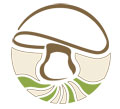
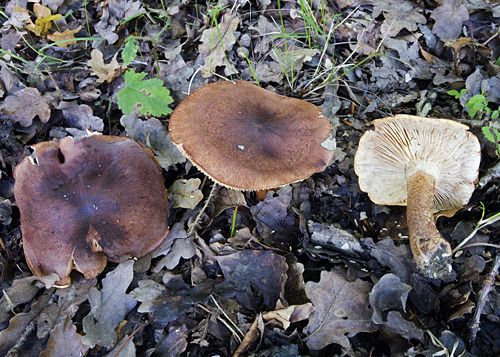
.jpg)
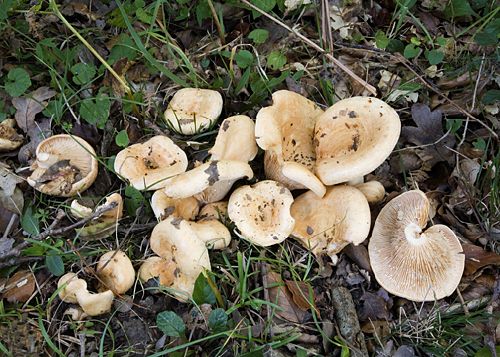
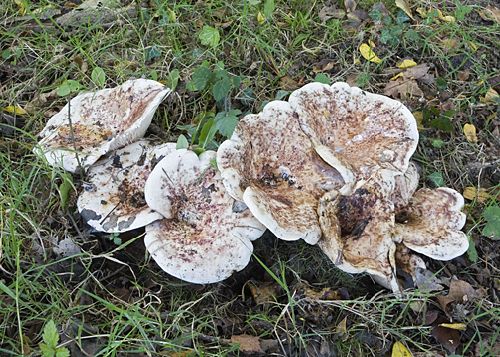
.jpg)
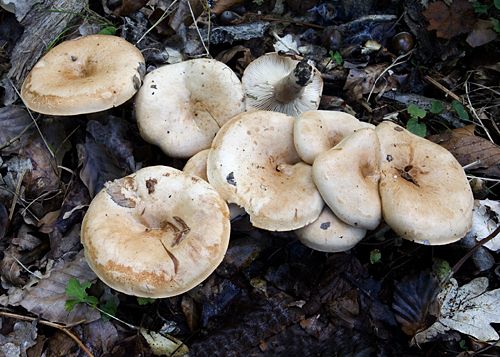
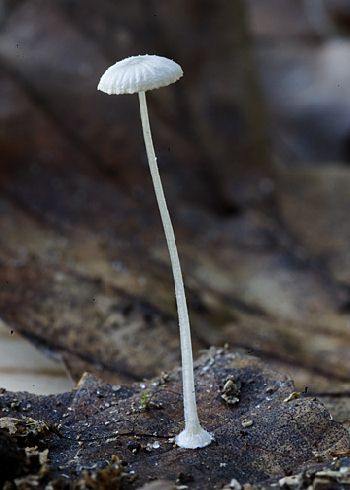
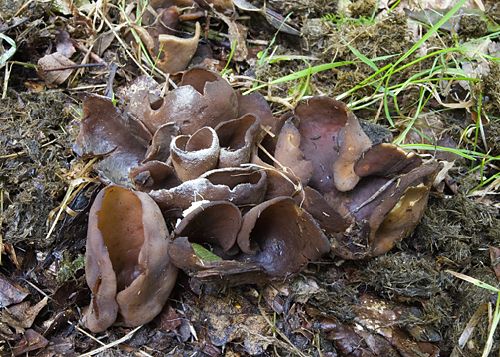
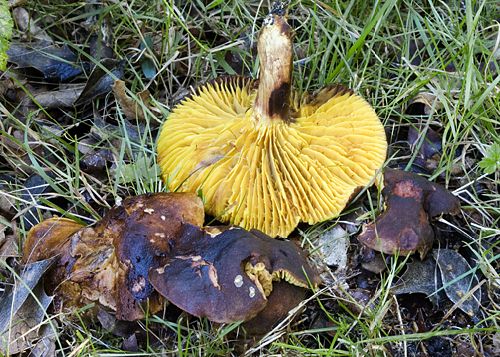
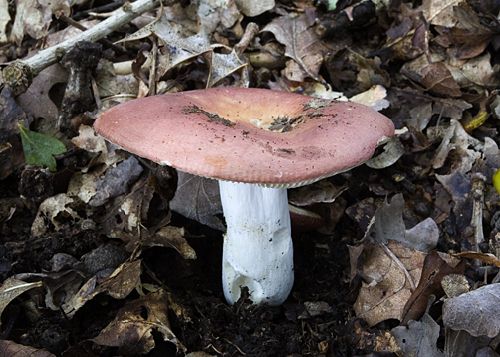
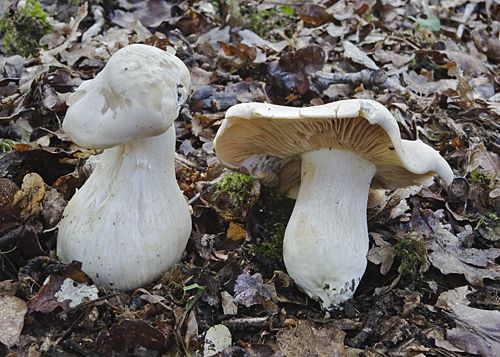
.jpg)
